Market Growth Projections
The Global Fuel Cell Bike Market Industry is poised for remarkable growth, with projections indicating a rise from 0.56 USD Billion in 2024 to an impressive 6.0 USD Billion by 2035. This trajectory suggests a robust compound annual growth rate (CAGR) of 24.05% from 2025 to 2035. Such growth reflects increasing consumer interest in sustainable transportation solutions and the ongoing development of fuel cell technology. The market's expansion is likely to attract investments and innovations, further enhancing the appeal of fuel cell bikes in the global transportation landscape.
Technological Advancements
Technological innovations play a pivotal role in the Global Fuel Cell Bike Market Industry. Advances in fuel cell technology, such as improved efficiency and reduced costs, enhance the appeal of fuel cell bikes. For instance, the development of lightweight materials and compact fuel cells contributes to better performance and longer ranges. These advancements not only make fuel cell bikes more competitive against traditional electric bikes but also attract a broader consumer base. As technology continues to evolve, it is likely that the market will witness increased adoption, further propelling growth and innovation in the coming years.
Rising Health Consciousness
The growing focus on health and fitness among consumers is influencing the Global Fuel Cell Bike Market Industry. As individuals become more health-conscious, the demand for active transportation options, such as biking, increases. Fuel cell bikes provide an opportunity for exercise while also offering the benefits of clean energy. This dual appeal attracts a diverse demographic, from fitness enthusiasts to environmentally aware consumers. The intersection of health and sustainability is likely to drive market growth, as more people opt for fuel cell bikes as a means of promoting both personal well-being and environmental responsibility.
Growing Environmental Concerns
The increasing awareness of environmental issues drives the Global Fuel Cell Bike Market Industry. As urban populations expand, pollution levels rise, prompting consumers to seek eco-friendly transportation alternatives. Fuel cell bikes, which emit only water vapor, present a sustainable solution to urban commuting. This shift towards greener options is reflected in the projected market growth, with the industry expected to reach 0.56 USD Billion in 2024 and potentially escalate to 6.0 USD Billion by 2035. The anticipated compound annual growth rate (CAGR) of 24.05% from 2025 to 2035 underscores the urgency for sustainable transport solutions.
Urbanization and Traffic Congestion
Rapid urbanization and increasing traffic congestion are key drivers of the Global Fuel Cell Bike Market Industry. As cities expand, the demand for efficient and sustainable transportation solutions rises. Fuel cell bikes offer a practical alternative to traditional vehicles, allowing for easier navigation through congested urban areas. The convenience of fuel cell bikes, combined with their environmental benefits, positions them as an attractive option for urban commuters. This trend is expected to contribute to the market's growth, as more individuals seek efficient means of transportation in densely populated regions.
Government Initiatives and Incentives
Government policies and incentives significantly influence the Global Fuel Cell Bike Market Industry. Many countries are implementing regulations and subsidies to promote clean energy and reduce carbon emissions. For example, various governments offer tax credits and rebates for consumers purchasing fuel cell vehicles, including bikes. Such initiatives encourage the adoption of fuel cell technology, making it more financially accessible to consumers. As governments worldwide commit to sustainability goals, the fuel cell bike market is poised for substantial growth, aligning with global efforts to combat climate change and promote renewable energy sources.



















Leave a Comment